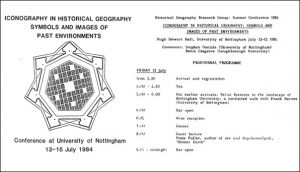July 10, 2024, by lzzre
Reflections on Iconography in Historical Geography at 40
A symposium hosted by the Cultural and Historical Geography research theme, 15th May 2024
A blog by Cristian Croitoru, Third Year Undergraduate Geography student
Back in mid-July 1984, the University of Nottingham staged a key event that helped define the field of cultural and historical geography. Held at Hugh Stewart Hall, the Iconography in Historical Geography: Symbols and Images of Past Environments conference was convened by Denis Cosgrove and Stephen Daniels. This small yet significant symposium planted the seeds for what would become one of the most important works in the field: The Iconography of Landscape: Essays on the Symbolic Representation, Design and Use of Past Environments (Cosgrove and Daniels, 1988).
A few weeks ago, I was fortunate enough to attend the 40th anniversary of the 1984 conference. Hosted by the School’s Cultural and Historical Geography Theme, this event was not just a nostalgic look back; it was a celebration of a legacy that continues to shape our field today. Dr Jake Hodder opened the conversation discussing the significance of small symposia and edited collections in shaping geographical fields. But beyond the conventional atmosphere, what was it about this conference that enabled the creation of The Iconography of Landscape? Was it the diverse and multidisciplinary nature of the gathering? Or the questioning of established ideas that attendees highlighted throughout the conversation?
Daniels himself spoke of the need to problematise established ideas. The conference presented an alternative vision of historical geography shaped by theory. Dr Susanne Seymour and Professor Charles Watkins discussed their experiences of attending the 1984 conference and how subsequent collection has influenced their teaching and research. As Seymour’s tutee, I came across Daniels and Cosgrove’s book early in my undergraduate studies – especially Brian Harley’s chapter on Maps, Knowledge, and Power. While non-geographers might consider maps a cliché within our discipline, their centrality in understanding spatial forms of knowledge across the social sciences and humanities cannot be overstated. For me, contributions, like Harley’s, taught me that maps are far more than coordinates on paper, they are tools for understanding complex spatial relations of power across societies and histories.
Next, Professor David Matless and Professor Mike Heffernan reflected on the edited collection. Matless, who helped compile the index for the book, discussed the practicalities of word processing in the late 1980s, including showing an excerpt of the original index printed by dot matrix which he found in his office. Heffernan reflected the reception the book received including some scepticism from the more-traditional Cambridge School concerning its theoretical contribution. However, in time the book was viewed as a timely contribution that geographers valued as they sought to venture into landscape studies and theories of visual culture (see della Dora et al., 2011 for commentaries).
The session then dived deeper into the chapters’ individual contributions, with three attendees discussing their interaction with the different essays from the collection, as well as providing a glimpse of their PhD journeys. Dr David Beckingham, whose research focuses on social regulation, drinking, and drunkenness, explored Mark Harrison’s essay on symbolism, crowd patterns, and their representational significance in nineteenth-century English towns. The Black Lives Matter movement is exemplary of the book’s continuing relevance. Certain areas, such as Bristol City Centre, have a particular symbolic impact on how protests are planned, mobilised, and reported, making them critical spaces for advancing scholarly discourse in spatial politics, urban geographies, and memory studies.
Upholding the topic of symbolic landscapes and their de-sanitisation, Dr Peter Martin considered Brian Osborne’s essay on The iconography of nationhood in Canadian Art as a lens on shifting debates of indigeneity and its representation in non-indigenous art. While there was an emerging sentiment to explore indigenous iconography, represented through Western art techniques, to diversify the discipline, Martin’s suggested a change in the ways we approach the subject. Rather than speaking for indigenous groups, recent work emphasises the inclusion of indigenous narratives in our discussions. This change challenges us to move beyond representation to actual engagement, ensuring that indigenous histories are told authentically and respectfully.
Closing the symposium was Enrico Priarone, a visiting PhD student from the University of Genova. Priarone presented a quali-quantitative analysis of landscape changes in the Upper Val di Vara (Liguria, Italy). Priarone’s work uses a blend of visual analysis and the concept of “landscape of practices” to reconstruct the evolution of landscape through photography, cartography, and comparison. The analysis facilitates discussions that span historical and quantitative comparisons of land use and forest distribution from the early twentieth to today. Subsequently, the latter complements qualitative descriptions of place from local populations. Priarone’s work expands our understanding of rewilding processes and the dynamic relationship with the changing landscape.
Finally, let us raise a glass to those contributors no longer with us! In their memory, I am crossing my fingers that my frantic notes taken from this session have morphed into an account not only highlighting the book’s importance but the necessity of celebrating and continuing a tradition; a tradition of challenging established ideas. Sometimes, one walks out of these events with a head spinning with ideas. Other times, they encourage new bodies of work in cultural and historical geography and beyond. Here is for keeping the flame alive, celebrating those who lit it before us, and paving the way for the future.
Relevant material
della Dora, V., Lorimer, H., Daniels, S. (2011). Denis Cosgrove and Stephen Daniels (eds) (1988) The Iconography of Landscape: Essays on the Symbolic Representation, Design and Use of Past Environments. Cambridge: Cambridge University Press. Progress in Human Geography. 35(2), pp.264-270. [Online]. Available at: https://journals.sagepub.com/doi/10.1177/0309132510397462.
Daniels, S. (2009). The making of The iconography of landscape. Cultural Geographies. 16(1), pp.12-15. [Online]. Available at: https://journals.sagepub.com/doi/abs/10.1177/14744740090160010106.
No comments yet, fill out a comment to be the first


Leave a Reply